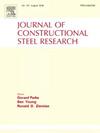Bond behavior of CFRP-to-steel interfaces with a typical ductile adhesive at low temperatures
IF 4
2区 工程技术
Q1 CONSTRUCTION & BUILDING TECHNOLOGY
引用次数: 0
Abstract
Externally bonded (EB) carbon fiber-reinforced polymer (CFRP) composites are increasingly used to strengthen aging steel structures. In strengthened structures, the bond interface between CFRP and steel serves as the primary stress transfer pathway but may deteriorate under extreme temperatures. This study investigates the bond behavior between CFRP and steel over a temperature range of −40 °C to 25 °C. Single-lap CFRP-to-steel bonded joints were tested using a newly designed holding device that induced pure mode-II stress at the bonding interface. Load-displacement relationships and CFRP strain distributions were recorded, facilitating the determination of interfacial stress distributions and bond-slip relationships. The results showed that bond-slip characteristics transitioned from a tri-linear (elastic-plastic-softening) to a bi-linear (elastic-softening) configuration as the temperature decreased, accompanied by a continuous increase in interfacial shear stiffness and a reduction in interfacial fracture energy. In addition, the derived bond-slip relationships were used in finite element modeling and validated by their close alignment with experimental data. Finally, the individual effects of thermal stress or bond property variations on the bond strength were analyzed separately utilizing an analytical solution.
求助全文
约1分钟内获得全文
求助全文
来源期刊

Journal of Constructional Steel Research
工程技术-工程:土木
CiteScore
7.90
自引率
19.50%
发文量
550
审稿时长
46 days
期刊介绍:
The Journal of Constructional Steel Research provides an international forum for the presentation and discussion of the latest developments in structural steel research and their applications. It is aimed not only at researchers but also at those likely to be most affected by research results, i.e. designers and fabricators. Original papers of a high standard dealing with all aspects of steel research including theoretical and experimental research on elements, assemblages, connection and material properties are considered for publication.
 求助内容:
求助内容: 应助结果提醒方式:
应助结果提醒方式:


